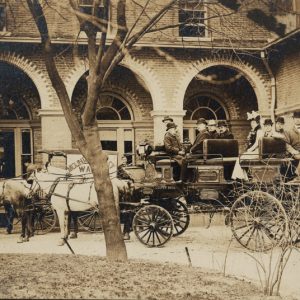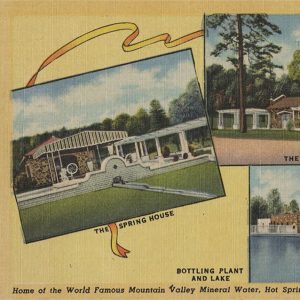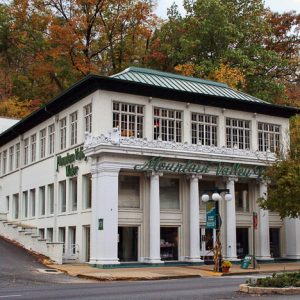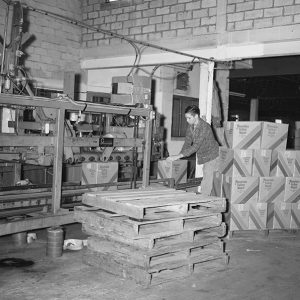calsfoundation@cals.org
Mountain Valley Spring Water
Mountain Valley Spring Water, a brand name for bottled spring water from Hot Springs (Garland County), originated in the 1870s and rose to nationwide prominence, as did the town of Hot Springs, due to a reputation for curative powers.
In 1871, pharmacist Peter E. Greene and his brother, John Greene, originally from Arkadelphia (Clark County), were the first to sell Mountain Valley Spring Water, which was then known in the Hot Springs area as “Lockett’s Spring Water” because of its association with Benjamin Lockett and his son, Enoch. The Locketts owned the spring and were the first to recognize its unusual qualities, particularly its purity and beneficial mineral content. The Greenes purchased the land from the Locketts, improving the spring site and constructing a two-story hotel, initially called the Mountain Valley Resort Hotel and, later, the Mountain Valley Hotel and Sanitarium. The brothers renamed the water Mountain Valley after a small community nearby. John Greene oversaw the spring and managed the hotel, while Peter moved to downtown Hot Springs to establish the first distributorship at 195 Central Avenue. Mountain Valley water originates at a protected spring on what was then the grounds of the hotel, just west of the present Highway 7 North, approximately twelve miles from downtown Hot Springs.
In the summer of 1879, Mr. W. N. Benton, an insurance agent formerly of St. Louis, Missouri, purchased the business and properties from the Greene brothers, planning to expand the hotel and the distribution of the water. Benton was confident of his product’s appeal because, like its European counterparts, Mountain Valley Spring Water was touted, in letters of endorsement appearing in various publications, as offering cures for such ailments as dyspepsia, dropsy, Bright’s Disease, and liver and kidney ailments. As a result of such publicity, it soon reached customers from Maine to Texas.
In 1883, the Mountain Valley Water Company was officially formed, with Zeb Ward, G. G. Latta, Samuel Fordyce, and Samuel Stitt as principal investors and company officers. Peter Greene remained as local manager. In December 1892, Ward bought out the interests of his partners and, as sole owner, entertained plans, which were never realized, for building a railroad from Hot Springs to Mountain Valley and enlarging the hotel extensively. In 1894, the company established a distribution center in Philadelphia, marking what is believed to be one of the first franchises of an American business.
Ownership of the spring was transferred again in 1902, when August Schlafly of St. Louis, already a major stockholder in the company, and his family became sole owners. By 1908, franchise offices had followed in Chicago, Illinois, and New York City. An apocryphal tale holds that two strangers, traveling home to New York from Hot Springs by train, were in the dining car, and each produced a bottle of Mountain Valley for his respective table. This coincidence led to much conversation and then an agreement to form a fifty-fifty partnership for a Mountain Valley Water Company franchise in New York. Upon exchanging business cards, media mogul William Randolph Hearst discovered that his new partner was the well-known gambler Richard Canfield, a man against whom his newspapers were conducting a fierce campaign.
By the 1920s, Mountain Valley Water was being served in the United States Senate, and in 1928, distribution began in California, making Mountain Valley the first bottled water to be available coast to coast.
In 1924, Schlafly purchased the DeSoto Springs Mineral Water Company, located at 150 Central Avenue in Hot Springs in two-story Classical Revival brick building, specifically built to house a mineral water depot. A third level was added in 1921 to house a Japanese-themed dance hall, with accommodation for a live band. The building remained the DeSoto Spring Water Depot and DeSoto Dance Hall until 1936, when Mountain Valley Water Company made the building its national headquarters and visitors’ center.
The original and popular two-story hotel in Mountain Valley burned in the late 1880s and was replaced by a much larger three-story structure. The newer hotel received national newspaper coverage when it, too, burned in 1934 while the well-known singer and radio star Kate Smith was a guest. The hotel was never rebuilt.
In an effort to discover what ingredient or ingredients made this spring water different from its competitors and beneficial to those with chronic disorders, the company encouraged the clinical and biochemical study of the water and its possible therapeutic effects in the 1920s and 1930s. Clinical tests at hospitals in New York, St. Louis, and Philadelphia demonstrated improvements in the health of patients suffering from kidney and liver disorders and rheumatism as a result of drinking Mountain Valley Water. Studies after World War II in facilities in New York, Cincinnati, Chicago, St. Louis, and Houston further investigated the connection between the low-sodium content of the water and its alkaline buffering ability. The extensive testing of the spring water enabled the company to present a strong and successful defense to 1956 allegations by the Food and Drug Administration that its advertising claims were too broad and exaggerated.
In 1966, the Schlaflys sold the company to a group of distributors under the leadership of John G. Scott. The company’s headquarters were moved to Paramus, New Jersey, and the historic Mountain Valley building was closed. In April 1987, Sammons Enterprises of Dallas, Texas, purchased the company and returned administrative operations to Hot Springs. On March 12, 1988, the renovation of the historic headquarters was completed. The structure had been placed on the National Register of Historic Places as part of the Central Avenue Historic District on June 25, 1985. The company built a molding facility at the spring site for the production of plastic bottles in 1996. In 2004, the company was purchased by Clear Mountain Spring Water of Little Rock (Pulaski County), and ownership returned to Hot Springs. The administrative offices remained at 150 Central Avenue in downtown Hot Springs, on the level previously occupied by the “Japanese Ballroom,” the ceiling and period fixtures of which were completely restored. The first floor houses a visitors’ center with display of historic materials relating to bottled water, with particular focus on Mountain Valley, as well as a retail outlet for Mountain Valley products. Visitors are also welcome to visit the spring for weekly tours of the plant and grounds. In 2018, the company purchased the former Fountain Lake Resort property in Fountain Lake (Garland County) with the intent of tapping a spring on the property.
International beverage distributor Cott Corp. acquired Mountain Valley in October 2018 for $78.5 million.
Calvin Coolidge was the first American president to serve Mountain Valley Spring Water in the White House. Following a heart attack in 1955, President Dwight Eisenhower drank the water on the advice of his physician. Other notable connoisseurs of the water included Elvis Presley and boxing champions Joe Louis, Gene Tunney, and Sugar Ray Robinson. Consumption of the water has not been limited to humans: thoroughbreds such as Secretariat, Nashua, Kelso, Bold Ruler, and Sunday Silence were trained on the spring water.
For additional information:
Cline, Inez. “Mountain Valley Spring Co., 1871–1971.” The Record 12 (1971): 1–8.
Mountain Valley Spring Water. http://www.mountainvalleyspring.com (accessed May 5, 2025).
Oatsvall, Neil S. “Advertising Nature and Health: Mountain Valley Water Company, 1871–2015.” The Record (2016): 5.1–5.10.
———. “Bottling Nature’s Elixir: The Mountain Valley Spring Water Company, Environment, Heath, and Capitalism.” Arkansas Historical Quarterly 78 (Spring 2019): 1–31.
Schnedler, Jack. “High Water Mark: Hot Springs’ Mountain Valley Spring Water Marks 150 Years.” Arkansas Democrat-Gazette, August 3, 2021, pp. 1E, 6E. Online at https://www.arkansasonline.com/news/2021/aug/03/high-water-mark/ (accessed July 27, 2023).
Scully, Francis J. Hot Springs, Arkansas and Hot Springs National Park: The Story of a City and the Nation’s Health Resort. Little Rock: Hanson Co., 1966.
Talk Business & Politics Staff. “Publicly-traded Beverage Company Acquires Hot Springs-based Mountain Valley Spring Co. for $78.5 Million.” Talk Business & Politics, October 15, 2018. https://talkbusiness.net/2018/10/publicly-traded-beverage-company-acquires-hot-springs-based-mountain-valley-spring-co-for-78-5-million/ (accessed May 5, 2025).
Anne Wagner Speed
Little Rock, Arkansas


 Arlington Hotel
Arlington Hotel  Mountain Valley Plant Workers
Mountain Valley Plant Workers  Mountain Valley Postcard
Mountain Valley Postcard  Mountain Valley Spring
Mountain Valley Spring  Mountain Valley Spring Water
Mountain Valley Spring Water  Mountain Valley Spring Water Headquarters
Mountain Valley Spring Water Headquarters  Mountain Valley Spring Water
Mountain Valley Spring Water  Zeb Ward
Zeb Ward 



Comments
No comments on this entry yet.